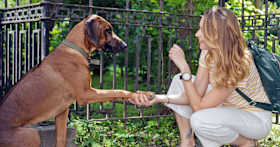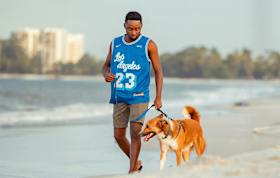Am I Too Busy for a Dog?
Dogs need attention, love, and a trusting connection with their pet parent.
Dogs need attention, love, and a trusting connection with their pet parent.
by Mia Nguyen, CPDT-KA, FFCP, | July 8, 2025

Evgeniya Rubtsova / Adobe Stock
Dogs need more than just the basics: food, water, shelter, vet care, safety, and enrichment. To truly thrive and build a strong bond, they need attention, training, mental and physical stimulation, and emotional connection. Ask yourself if you have the time and energy to give a dog the care, attention, and connection they need each day for the rest of their life — not just to get by, but to flourish. So, whether you’re getting your first dog or adding another one to your home, it’s crucial to consider if your lifestyle can support a new pup. This guidance can help you decide if you’re too busy to adopt a dog.
Before adopting a pet, people often underestimate how much time dogs really need. And some dogs need a lot more time than others. Most dogs require at least a few hours of attention and care each day. But the amount of time you need to dedicate to a dog depends on several factors.
Age: Puppies and young dogs need more time dedicated to them to meet their basic needs. Puppies need constant supervision, frequent potty breaks, and short bursts of exercise, socialization, and basic training. Meanwhile, young adult dogs, if not appropriately exercised both physically and mentally, may become destructive.
Energy level: Dogs, like people, have varying energy levels. Some dogs are couch potatoes, happy to sleep for the majority of the day at home, while others are adventure buddies who want to be doing outdoor activities with their people. The more energy your dog has, the more time you will need to dedicate to them.
Existing training: You may not have the need or desire to become a trainer for your dog, but basic training is vital to making sure you and your dog live together harmoniously. Dogs with little-to-no training may need more of a commitment from you to help learn house rules and boundaries.
Living environment: Your home environment will also impact how much attention your dog requires. If you live in an apartment, your dog will need to be taken out for potty and exercise, whereas if you have a fenced home, you may be able to travel a significantly shorter distance to meet your dog’s needs
Household dynamics: Factors such as kids, roommates, and work schedules will impact the additional time you’ll need to set aside for your dog. If you have housemates or a family who can help care for your dog — or if you work from home — your dog’s need for companionship and supervision can be more easily met.

Milles Studio / Stocksy
The short answer is: The amount of exercise a dog needs depends on their energy level, age, and size. Most dogs need at least 30 minutes of exercise a day. Although some dogs do well with only 30 or so minutes of exercise daily, others thrive on two hours of adventure with their pet parents. When determining how much time to dedicate to exercising your dog, it’s important to also consider mental exercise: If you struggle with taking your dog outside enough, consider increasing their mental exercise to make up for it.
Generally, puppies benefit most from frequent, but small and short, sessions of mental and physical exercise while they are still growing. Senior dogs may also benefit from shorter sessions of physical and mental activity, depending on their mobility and health. The amount of exercise a dog needs varies the most during adulthood. The amount of mental and physical exercise an adult dog will need depends on their energy level and size.
If you find that your dog is exhibiting undesirable behaviors such as excessive barking, chewing, or destroying furniture, it may be because they aren’t getting enough physical or mental activity.
Before bringing home a new dog, consider what your new dog (or their parent mixes) may have been originally bred to do.
Working breed dogs — such as Huskies, German Shepherds, Corgis, and Aussies — will need more daily exercise. They will also need more mental enrichment. Generally, working breed dogs require at least an hour of physical exercise and at least an hour of mental enrichment each day. However, because each dog is different, you may find a working breed dog (especially their mixes or seniors) who is quieter and happy to lie around. Regardless, if you bring home a working breed dog, expect to dedicate more time to physical and mental enrichment.
Not all dogs require a ton of exercise; there are definitely low-maintenance and laid-back breeds and mixes out there. Small dogs tend to need less exercise. Generally, the following types of dogs need less exercise.
Brachycephalic (short-snouted) breeds: Due to their shorter snouts, these flat-faced dogs will need more breaks in exercise or simply less exercise. They are more prone to breathing issues and overheating during warmer times of the year.
Toy and companion breeds: Because these dogs were bred for indoor companionship and not work, they are less likely to need hours of exercise
Heavier, short-legged breeds: Not typically bred for endurance or running, breeds such as Basset Hounds or Bulldogs would make great companions for someone looking for a lower-energy dog.
Senior or health-challenged dogs: As with humans, older dogs need less exercise due to limited mobility and lack of endurance. They may also simply prefer more rest.

Jovo Jovanovic / Stocksy
If you are a busy pet parent, there are still options for you to raise a happy and healthy dog.
Choose a dog who matches your actual lifestyle. If you’re not an active outdoor enthusiast, consider a dog who’s more independent, requires less exercise, or is already crate-trained. Older dogs and some mellow rescue mixes are total gems and are often a better fit than a young Australian Shepherd for busy people.
Time-block for your dog like you do for meetings. If you’ve already brought home your new dog, try weaving their activities into your daily routine to make it feel less like a chore and more likely to happen. You can turn meals into physical and mental enrichment activities, and integrate training sessions or bigger adventures into your weekends or days off.
Ask for help from friends and professionals. Getting help may be beneficial for longer days away from your dog. Consider hiring a dog walker, asking a dependable friend, swapping dog-sitting with your neighbor, or scheduling daycare a few days a week.
Yes, you can have a dog if you work 9 to 5, but you should plan accordingly to make sure their needs are met. Consider doggy daycare or a dog walker if you can’t bring your dog to work with you. This is important in making sure their mental, emotional, and physical needs are met while you are away.
Dogs don’t measure time like humans, but they do perceive duration through circadian rhythms (or day/night cycles), routine cues (such as sounds, smells, or sunlight), and memory and emotion (associating events with feelings). Time can also feel longer to a dog who is not stimulated, understimulated, and/or lonely. Leaving enrichment toys, playing calming music, and maintaining a consistent routine can help your dog when they’re away from you.
Burke, Anna. “How Much Exercise Does a Dog Need Every Day?” American Kennel Club, April 16, 2024. www.akc.org/expert-advice/health/how-much-exercise-does-dog-need.
“General Dog Care.” ASPCA. www.aspca.org/pet-care/dog-care/general-dog-care.
“How Much Exercise Is Enough Exercise for Your Dog?” Animal Humane Society. www.animalhumanesociety.org/resource/how-much-exercise-enough-exercise-your-dog.
Michaels, Linda. “The Hierarchy of Dog Needs.” Do No Harm Dog Training. www.donoharmdogtraining.com/hierarchy-of-dog-needs-presentation.
Scozzari, Gaetano. “Can Dogs Tell Time?” Pawsitive, June 7, 2024. pawsitive.com/blogs/news/can-dogs-tell-time.
“Unlocking the Mystery: How Dogs Can Tell Time.” VCA. vcahospitals.com/shop/articles/how-dogs-can-tell-time.

Mia is a Certified Professional Dog Trainer and Behavior Consultant with a deep passion for helping dogs and their families build positive, lasting relationships. As the owner and trainer of Ace’s Pace based out of Sacramento, CA, she focuses on fear-free, science-backed techniques to guide pet parents through the nuances of dog behavior, training, and enrichment. Through a gentle, positive approach rooted in understanding and trust, Mia strives to help every dog live their best life, with the support and guidance that pet parents need to be successful. You can follow Mia and her life with dogs on Instagram at aces.pace.sacramento.

Behavior & Training

Adoption Advice

Adoption Advice

Breed Info
Thinking of adopting a working breed dog? Learn more about working breeds and what it takes to keep them as pets.

Adoption Advice
Considering getting a pet but unsure if you want a cat or dog? Here are 10 differences to consider.

Behavior & Training
Plus, how to create a schedule that works for both of you.

Adoption Advice
Bringing a new puppy into the house? Learn how to create a safe, comfortable space in every room for their first days.

Adoption Advice
New rescue dog? Don’t panic — here’s your survival guide for the first few days and how to connect with your new best friend.

Behavior & Training